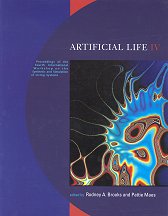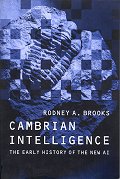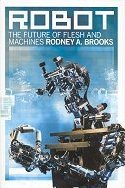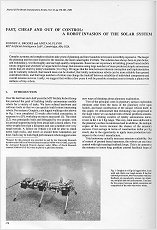This is Brooks' take on the science of intelligent robots, and could
be considered as a "pop science" version of Cambrian
Intelligence, also bringing us more up to date on what has
been happening since the early 1990s. Brooks bases his approach on the
subsumption architectures, a situated, embodied, "bottom-up"
approach to intelligent behaviour, as opposed to Good Old-Fashioned
AI's symbolic reasoning top-down approach. It also serves as Brooks'
riposte to Moravec's book of the
same name. Whilst expressing the greatest respect for Moravec,
Brooks emphatically disagrees with his approach:
p28.
He has carried this conviction for more
than twenty-five years, and his latest research project at Carnegie
Mellon University is his umpteenth implementation of an even better
three-dimensional reconstruction program. I have tried to convince him
over the years that (1) animals, including humans, do not make
accurate three-dimensional maps and are still able to act
intelligently in the world, and that (2) once he has these maps he is
going to have to do something clever with them, so perhaps it is worth
thinking about that problem a little now in order to guide
requirements on the characteristics of the maps. I have yet to
succeed.
Some problems seem to be fundamentally harder than others to solve,
and it's not the ones AI researchers have been concentrating on:
p36.
Judging by the projects chosen in the
early days of AI, intelligence was thought to be best characterized as
the things that highly educated male scientists found challenging.
In fact, it's the everyday problems: movement, navigation,
recognising and manipulating things in a complex noisy environment,
that have posed the main challenges.
As well as castigating the GOFAIers, Brooks also lays into those
carbon chauvinists who deny that "mere machines" could ever
be intelligent or have real emotions, but rather claim that something
extra is needed. He dismisses the circular "arguments"
against "mere machines" of people like Penrose and Searle,
identifying them as "tribalistic" arguments of people who
can't bear to give up the idea that we are somehow special, somehow
other.
p180.
Like Searle's Chinese Room, there is no
real argument made against a beer can computer being
intelligent---mere ridicule is used. Sort of like the idea that the
world can't possible be round because everybody in Australia would
fall off. Ridicule does not make a valid argument. Ridicule instead of
reason is a well-known refuge for tribalism.
(However, this dismissal seems to ridicule the use of ridicule.) He
claims an existence proof that machines can have emotions, because
we are machines. He does have the feeling that there is
something currently missing from our descriptions, which he calls "the
juice", and cheerfully admits he has no evidence for this claim.
However, he does not believe that this is necessarily anything new,
just something we haven't recognised yet, and is not something that we
couldn't build into our machines.
The argument is interspersed with a few wry anecdotes from his
career:
p188.
When I first expounded this theory at a
workshop in Switzerland, I was forty years old. At dinner that evening
a young graduate student from Oxford told me that what I had said was
very interesting and that he thought a lot of people came to similar
sorts of ideas when they were in the sunset of their careers.
So what has Brooks been up to more recently? It seems one of the
ways he has branched out is to make commercial robots. He too promises
us the house cleaning robot soon [still waiting!], but his main foray
seems to have been to sneak these critters into our homes in a
friendlier way, as toys. This has required getting to grips with
production engineering and marketing.
He moves on to talk about the future. The first step is interesting:
he suggests that the first major use of domestic robots might be to
provide us with telepresence, providing us with robots that we
control, instruct, and guide around our houses via a high-level Web
interface. Don't worry about providing the robot with those difficult
higher levels of reasoning and intelligence, just use the subsumption
architecture to provide the low level motor controls, allowing the "driver"
to issue higher level commands. He weaves some interesting scenarios
in this area.
Brooks then moves on to the further future, by way of artificial
retinas, to full cyborg enhancements, including more intelligence "in
your head". Some of his ideas echo
Andy Clark's notions here. But
I think this may again be far harder than is thought. For example, he
talks of augmenting memory so that the answers are "just there":
p229.
When we think of our own
[telephone] number,
we do not conjure up a visual image of the digits. Instead, the "number,"
whatever that means, is just there.
When I read this, I thought "speak for yourself!" When I
think of a telephone number, I do get a visual image of the
digits. Moreover, I have no idea how else I could possibly
think about a number. (Except for small numbers, where I get a
visual image of something more like a dice face pattern.) Brooks'
mental representations clearly are very different from mine. If we all
have internal representations that differ so dramatically, there may
be no one single technology that provides the promised augmentation.
But it's going to be fun getting there, and I suspect that Brooks'
approach has a lot to offer.



